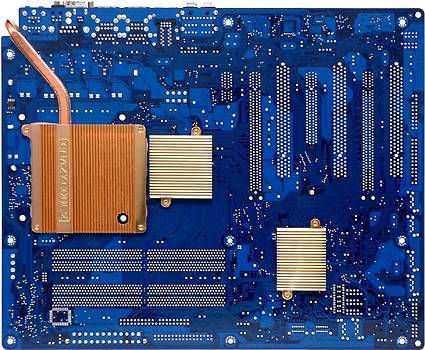Nvidia 680i Motherboard Comparison Part 2
Overclocking
A general annoyance about Gigabyte BIOS is that it usually displays the word "OK" in the voltage monitor rather than an actual reading, and that trend continues in the GA-N680SLI-DQ6. This becomes an excessive complication for the less initiated in following any tuner's "recommended" voltages because the BIOS also uses plus values, rather than absolute values, for several adjustments.
Knowledgeable users will note that 0.775V over default RAM voltage is 2.575V, but novices may forget that DDR2 voltage starts at 1.80V, and who really wants to do the math? Annoyances aside, the range of settings is more than adequate for most overclocking efforts.
| BIOS Frequency and Voltage settings (for overclocking) | |
|---|---|
| FSB Frequency | 100 - 650 MHz (1 MHz) |
| Clock Multiplier Adjustment | Yes |
| DRAM Frequency | 400-1400 MHz Data Rate |
| PCIe Clock | 100-131 MHz (1 MHz) |
| SPP-MCP HT Link Clock | 200-500 MHz (1 MHz) |
| CPU Vcore | 0.6875 - 1.600 - 2.375 Volts (0.00625/0.025 Volts) |
| CPU FSB Voltage | Default - +0.35 Volts (0.05 Volts) |
| Northbridge (SPP) | Default - +0.35 Volts (0.05 Volts) |
| Southbridge (MCP) | Default - +0.35 Volts (0.05 Volts) |
| Chipset Link Voltage | Default - +0.35 Volts (0.05 Volts) |
| DRAM Voltage | Default - +0.775 Volts (0.025 Volts) |
| CAS Latency Range | |
| tCAS: 1-6; tRCD: 1-7; tRP: 1-7; tRAS: 1-31; Command Rate: 1T/2T |
The GA-N680SLI-DQ6 reached the same 3460 MHz at 346 MHz bus clock (FSB 1384) as most other motherboards have with this stubborn E6700 test processor, at 10x CPU multiplier and 1.50 volts. Dropping the CPU multiplier to 6x only increased bus speed clock-ability to a meager 366 MHz (FSB 1466). Settings between 366 and 370 had no affect on actual speed, and 372 MHz simply refused to boot. A Port 80 display may have been handy!
Accessories
Gigabyte sent its sample prior to final packaging, but that leaves a bit of room in this comparison to focus on a "built in" accessory, Gigabyte Crazy Cool 2. Small sinks beneath the Northbridge, Southbridge and processor are meant to alleviate hot-spots caused by the integrated circuits above.
Gigabyte has improved Crazy Cool performance by adding a heatpipe to version 2, connected to the VRM sink via removable pins. Yes, it can still be removed!
Removing the device is probably not recommended by Gigabyte but may be required to install the support plates of many larger CPU cooling devices. Both versions of Crazy Cool are only designed to work with pin-mounted coolers such as the stock Intel part and the tested Cooler Master Hyper TX, and buyers should be aware of the potential loss of this feature when considering cooling options.
Get Tom's Hardware's best news and in-depth reviews, straight to your inbox.
Current page: Overclocking
Prev Page Gigabyte GA-N680SLI-DQ6: A Smorgasbord Of Features Next Page MSI P6N Diamond: Baked Alaska
